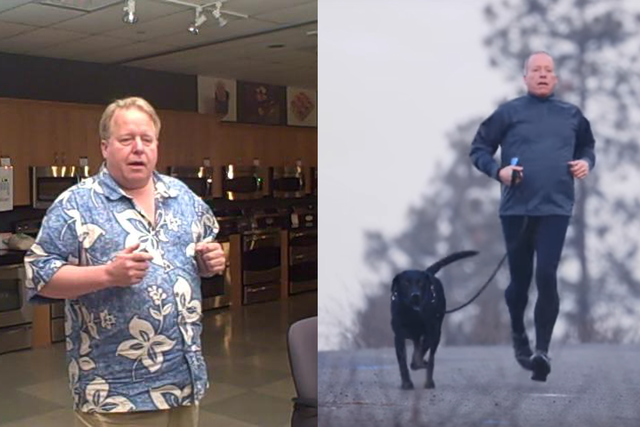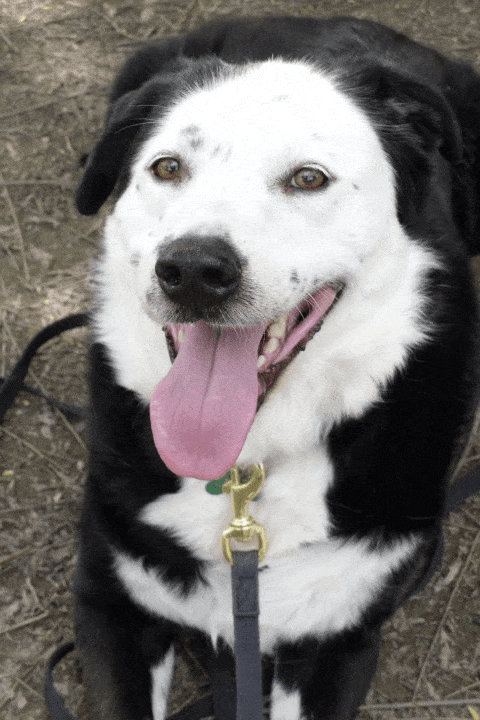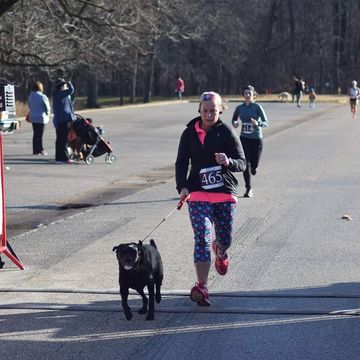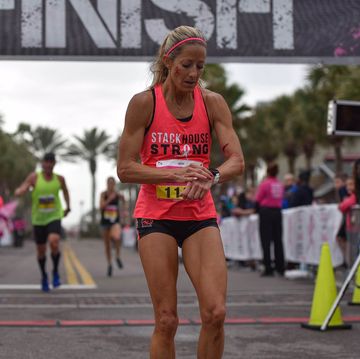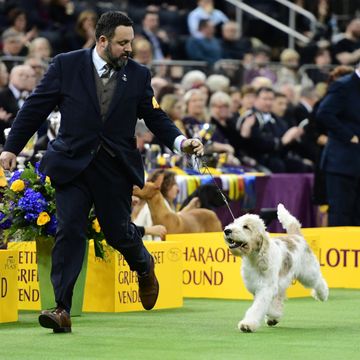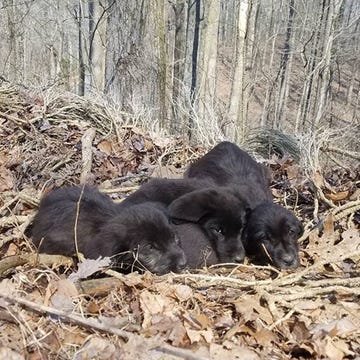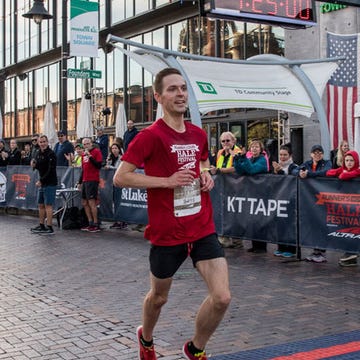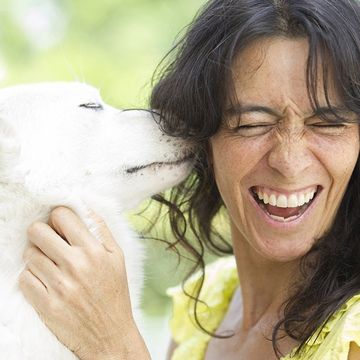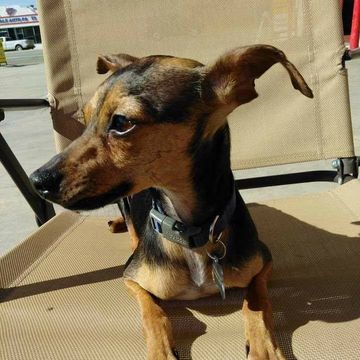Peety was seven—middle-aged for a dog—when a handler from the Humane Society Silicon Valley led him into the visiting pen. His black and white coat had missing patches of fur, from a skin rash. He was 25 pounds overweight. His tail drooped. When he slowly cocked his head to look at the man standing in front of him, the dog looked like he could have let out a lethargic sigh. It would probably sound like Eeyore from Winnie-the-Pooh.
The man weighed 340 pounds, was 51 years old, and wasn’t that impressed with Peety either. He’d come to the shelter to adopt the perfect dog: small, well behaved, didn’t shed. He imagined taking home an eight-pound golden retriever. Those don’t exist, so the shelter employees brought out Peety.
It was December 2010. Eric O’Grey went home to sleep on a decision to adopt. Peety wasn't anything like he wanted, because Peety was exactly like himself: lethargic, reaching middle age, and overweight.
The next morning, O'Grey figured if he was going to change his life, he might as well do it with his canine doppelganger. Peety waddled through the threshold in O’Grey’s San Jose, California, home and lay down by the window.
* * *
Airlines will delay flights if they run out of seatbelt extenders. O’Grey learned this on a cross-country flight from Louisville to San Jose in November 2010. He sat in an aisle seat, his midsection spilling over the armrests and touching the man next to him. A flight attendant informed O’Grey that she needed to call in an extension from another flight before the plane could leave.
It took more than 30 minutes. The man next to O’Grey looked over and said, “I am going to miss my connection because you are too fat.”
O’Grey was humiliated. The next day, after watching a segment about Bill Clinton’s plant-based diet on CNN, O’Grey called a naturopathic doctor. At the first appointment, the doctor told him to do two things immediately: throw out everything in his pantry, and adopt a shelter dog.
O’Grey ravaged the shelves in his kitchen, trashing all of the processed food. He then made a trip to the Humane Society Silicon Valley. A dog, the doctor said, would force him to go outside and be social.
Peety did not want to be social at first. He stayed in a different room for a few days. His previous owners left him chained up, outside with an unlimited amount of food. Not unlike O’Grey, who would regularly eat two extra-large Domino’s pizzas for dinner.
“He was the exact canine version of myself,” O’Grey said. So they both made the same lifestyle changes, going on 30-minute walks twice a day and eating a vegan diet. “I started losing five pounds a week. It came off like magic.”
Over one year, O’Grey shed 140 pounds. Peety lost 25. “He became a babe magnet; he attracted women,” O’Grey, who was and still is single, said. “When I was overweight I felt invisible to people. Peety and I started feeling really good together.”
The weight loss and the duo’s confidence accelerated when O’Grey started to run.
* * *
For months O’Grey struggled to find an exercise he liked. The gym felt monotonous, plus Peety couldn’t join him. In early 2012, they drove to San Jose State University’s dilapidated track.
In the 1960s, the university had the best track program in the country. The two Americans foisting a black power salute in the famous photo from the 1968 Summer Olympics both ran at San Jose State, on the same track that O’Grey parked next to for his first running workout. He felt inspired by the significance of the grounds, despite the potholes scarring several lanes and the beat-up infield now used as a parking lot for football games.
“I knew the history of that track, and I decided I was going to start running on that very same track,” O’Grey said. He ran one mile the first day, two miles the second day, three on the third, and four on the fourth. Peety watched out of an open window in the front seat of the car.
“I hated it, but somebody told me that if I stuck with it for two weeks, a light bulb would go off,” O’Grey said. He joined a local running club, and ran his first race—a half marathon—in February 2012.
“I guess I like doing difficult things that take a long time,” O’Grey said. “Running at the beginning of the day gave me self respect. I blossomed. I started becoming the person I wanted to be.”
O’Grey started running up to 80 miles a week. He ran his first marathon in May 2012, running one nearly every other month. Peety became a fixture at running club events and races. Getting older himself, the dog—now perky with a glistening, full coat of black and white fur—was only able to run a few miles, but he would join O’Grey at water stops when they volunteered at races.
The dog and his owner’s confidence soared. “I started hosting dinner parties for charity and became a lot more social,” O’Grey said. “I remember at one dinner party, all of sudden everyone noticed they were standing in the same corner. Peety had used his muzzle to herd everyone together.”
In 2014, the duo moved to Seattle for O’Grey’s work as a salesperson for the appliance company Whirlpool.
Peety started having problems walking in early 2015. Veterinarians found an inoperable tumor on his abdomen. For two days, O’Grey skipped work and lay on the floor of his apartment with his arms wrapped around Peety.
“When he died, I was just talking to him and he just shuddered. I could feel the life leave him,” O’Grey said. “I told him to wait for me. That I would come get him eventually.”
It was March 11. “The saddest day of my life,” O’Grey sad. “I was just destroyed. Meeting Peety and losing the weight together, I had never experienced a relationship like that before with any creature or person. A love that deep is an absolute bond.”
* * *
O’Grey stopped running for three months.
“I wasn’t over it, and I am still not,” he said. But the miles beckoned. So he laced up running shoes and started participating in races again. This time, with no dog.
“Three or four months after it happened, I was at my doctor’s office and the receptionist had a picture that looked just like Peety,” O’Grey said. “I told her about Peety and she told me that a new dog will eventually start looking for me, and when it happens, I will know.”
It happened, naturally, after a race. O’Grey finished the Shore Run 10K on June 7, 2015.
“I got this really powerful urge to drive to a shelter right then,” O’Grey said. He still had his race bib on when he walked into the lobby of Seattle Humane. Salt streaked his cheeks.
Jake, a Labrador Rhodesian mix, was four years old with a dark brown coat. His muscles rippled when O’Grey first spotted him.
“He gave me this look like, ‘Dude, get me out of here,'” O’Grey said. The dog had checked in four minutes before O’Grey arrived. He wasn’t entered into the system yet.
“He came over to me, put his legs on my lap, and started licking the sweat on my face,” O’Grey said. If Peety was the canine version of O’Grey five years before, Jake was the canine version of him now. The pair ran 30 minutes together the next day.
“He is in just incredible shape,” O’Grey said. “He is the best looking dog I have ever seen.”
O’Grey and Jake are training to run a half marathon together. It has not been easy. Jake’s powerful legs tug against the leash. “I am confident he could run 6:30 miles if I could keep up,” O’Grey said.
In November, O’Grey wrote an essay about Peety and Jake that was published in Oprah Magazine. That turned into an eight-minute documentary filmed by the Humane Society Silicon Valley as part of the organization's "Mutual Rescue" initiative. It’s garnered more than 15 million views. “I am pretty sure my life has changed,” O’Grey said.
Though he admitted that even without the video and publicity, it already had. Peety helped O’Grey get his confidence back, lose 140 pounds, and start running. Jake has taken over, keeping O’Grey on the road.
“In a nutshell, my relationship with both of these dogs has made me a much more conscious and complete person,” O’Grey said. “I feel like Superman.”
In the background, while O’Grey chatted on the phone, Jake let out a bark early in the conversation. It sounded like he wanted to go for a run.
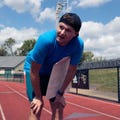
Kit has been a health, fitness, and running journalist for the past five years. His work has taken him across the country, from Hayward Field in Eugene, Oregon, to cover the 2016 Olympic Trials to the top of Mt. Katahdin in Maine to cover Scott Jurek’s record-breaking Appalachian Trail thru-hike in 2015.
